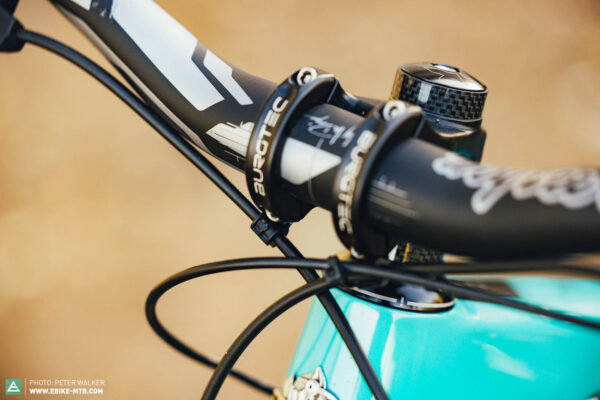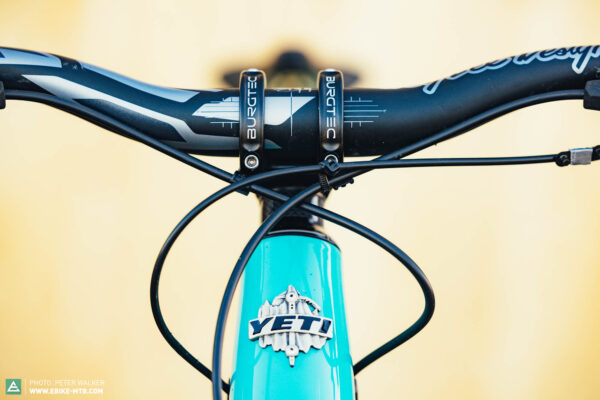With the updated CODE and Level brake models, SRAM have focused on an elegant, tidy look for a cleaner cockpit. The new series is intended to complement SRAM’s current brake models, essentially adding two top-tier models to the American manufacturer’s portfolio. We’ve already put the new CODE Stealth Ultimate model through the wringer for you.

Keyboard warriors watch out! SRAM just added two brand-new variants of their popular CODE and Level brakes to their portfolio. The main aim of the update was to move the whole lever body – and with them the brake lines – closer to the handlebars, preventing the hoses from forming a massive arc in front of the cockpit. This is a particular issue with the increasing popularity of headset cable routing. In-keeping with their name, the new Stealth models ensure a cleaner cockpit, making the brake lines almost invisible from the rider’s perspective. In addition, the brushed aluminium finish matches the new Eagle Transmission drivetrain, which SRAM launched alongside the new Stealth brakes. However, the updated Stealth models aren’t meant to replace the existing ones, but rather to complement and expand SRAM’s current brake line-up.


All the different SRAM Stealth 2023 brake variants
The CODE still remains SRAM’s powerhouse brake, and the CODE Stealth variant is mainly intended for downhill and enduro riding. The Level Stealth, on the other hand, is available as both a two-piston and a four-piston model, and is intended primarily for XC bikes. Both models are available in a top-tier Ultimate variant and more affordable Silver version. Prices range between € 220 and € 380 per brake, depending on the model and variant. To avoid any confusion, the Silver models are helpfully finished in black, while the more premium Ultimate variants have silver accents to make it clear that they are definitely not silver. Got it? The colour schemes are designed to fit in with the new Transmission X0 and XX drivetrains, so they make a bit more sense in context.






What’s different with the new SRAM Stealth 2023 brakes?
The obvious update is the look. In technical terms, the biggest change is the angle at which the lever unit sits on the bars, ensuring that the brake lines run parallel and close to the handlebars. Especially in combination with a wireless drivetrain and dropper post, this ensures a tidier cockpit and makes the brake lines almost invisible from the rider’s perspective. Moreover, an increasing number of bike manufacturers route the cables internally through the headset which, together with the new SRAM Stealth brakes, ensures a particularly tidy cockpit. We can imagine that some manufacturers will soon route the brake lines through the handlebars, which is already common with road bikes.




To make sure the brake lines are routed neatly, the new Stealth brakes come with additional cable clamps that can be secured to the lower stem bolt. However, if the cables on your bike aren’t routed through the headset – as is the case with our Yeti SB 160 – using the stem clips could result in a rather odd-looking cable loop in front of the cockpit – though this really depends on where cable ports are positioned on the frame. We used a small zip tie to prevent this from happening on our bike. SRAM’s Stealth brake models rely on exactly the same internals as their conventional counterparts and use the same bleeding tools, brake pads and other small parts.
How do the new SRAM CODE Ultimate Stealth 2023 brakes fare on the trail?
We had the chance to test the CODE Ultimate Stealth over several months on different bikes. We paired them with a HS2 220 mm rotor at the front and 200 mm disc at the rear. We put the new SRAM braking system through the wringer, pushing it to the limit in all conceivable riding scenarios, from our muddy home trails to the mild, dusty Spanish winter. Like with most brakes, installation is intuitive and straightforward. The only difference is that you’ll have to attach the two small additional stem clips to ensure a cleaner routing of the brake lines. Unfortunately, there’s one problem: the lever unit is positioned close to the handlebars, which makes it rather hard to attach an additional clamp. Simply put, if you don’t like the position of the levers using the Matchmaker clamp, have a separate clamp for your dropper remote, or like to use a different brand of drivetrain, you’ll either have to position the additional clamp right next to the brake clamp, or far inside the handlebars.


Given that the internals of the new Stealth brakes have remained basically unchanged, the brake feel hasn’t changed much either. That said, the new CODE Stealth has a slightly snappier bite point than the conventional CODE RSC, delivering the braking power more directly – albeit still far less directly than Shimano brakes. This is mainly due to the more direct power transmission of the carbon levers and the slightly thicker HS2 discs. As soon as you feel that the brake pads touch the rotor, you’ll feel noticeable deceleration. Nevertheless, the Stealth brakes still provide the same excellent modulation as the RSC model, which is what these brakes have always been known for.

The new SRAM Stealth brakes sport a new, elegant look that suits the clean cockpits of modern enduro bikes. Visually, they also fit in perfectly with the SRAM’s new Transmission drivetrains. Despite the face lift, the new CODE Ultimates are distinctly recognisable as SRAM brakes and provide a similar braking feel as the conventional CODE RSC. The bite point is a tad snappier, while the typical SRAM modulation remains basically unchanged, which means that SRAM brake fans will feel at home with the new Stealth series from the get-go.
Tops
- clean look
- forward-looking line routing
- snappy bite point with good modulation
Flops
- Lever design limits positioning of other clamps
- Untidy look, depending on the cable routing
- high price

You can find out more on the SRAM website.
Did you enjoy this article? If so, we would be stoked if you decide to support us with a monthly contribution. By becoming a supporter of E-MOUNTAINBIKE, you will help secure a sustainable future for high-quality cycling journalism. Click here to learn more.
Words: Simon Kohler Photos: Peter Walker, Mike Hunger









